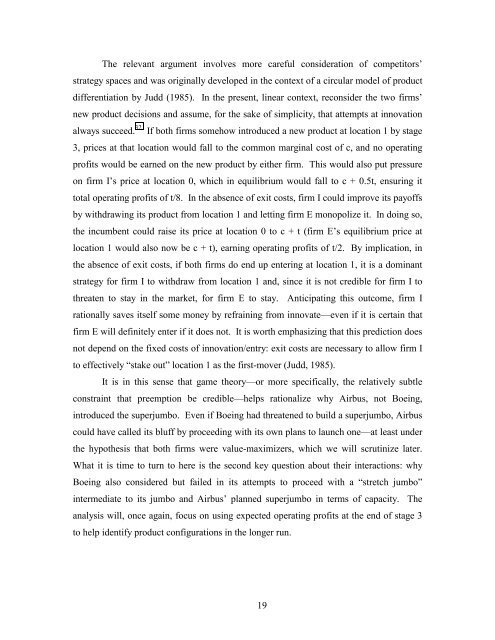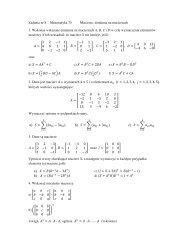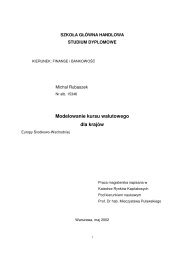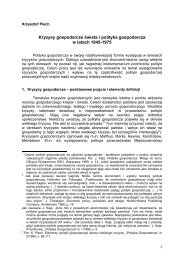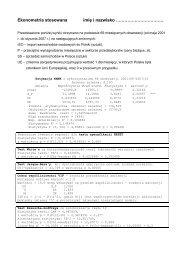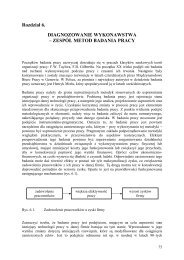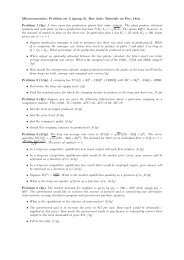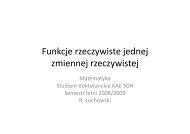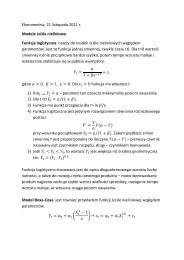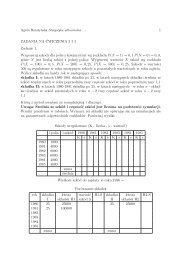“Airbus vs. Boeing in Super Jumbos: A Case of Failed Preemptionâ€Â
“Airbus vs. Boeing in Super Jumbos: A Case of Failed Preemptionâ€Â
“Airbus vs. Boeing in Super Jumbos: A Case of Failed Preemptionâ€Â
Create successful ePaper yourself
Turn your PDF publications into a flip-book with our unique Google optimized e-Paper software.
The relevant argument <strong>in</strong>volves more careful consideration <strong>of</strong> competitors’strategy spaces and was orig<strong>in</strong>ally developed <strong>in</strong> the context <strong>of</strong> a circular model <strong>of</strong> productdifferentiation by Judd (1985). In the present, l<strong>in</strong>ear context, reconsider the two firms’new product decisions and assume, for the sake <strong>of</strong> simplicity, that attempts at <strong>in</strong>novationalways succeed. 32 If both firms somehow <strong>in</strong>troduced a new product at location 1 by stage3, prices at that location would fall to the common marg<strong>in</strong>al cost <strong>of</strong> c, and no operat<strong>in</strong>gpr<strong>of</strong>its would be earned on the new product by either firm. This would also put pressureon firm I’s price at location 0, which <strong>in</strong> equilibrium would fall to c + 0.5t, ensur<strong>in</strong>g ittotal operat<strong>in</strong>g pr<strong>of</strong>its <strong>of</strong> t/8. In the absence <strong>of</strong> exit costs, firm I could improve its pay<strong>of</strong>fsby withdraw<strong>in</strong>g its product from location 1 and lett<strong>in</strong>g firm E monopolize it. In do<strong>in</strong>g so,the <strong>in</strong>cumbent could raise its price at location 0 to c + t (firm E’s equilibrium price atlocation 1 would also now be c + t), earn<strong>in</strong>g operat<strong>in</strong>g pr<strong>of</strong>its <strong>of</strong> t/2. By implication, <strong>in</strong>the absence <strong>of</strong> exit costs, if both firms do end up enter<strong>in</strong>g at location 1, it is a dom<strong>in</strong>antstrategy for firm I to withdraw from location 1 and, s<strong>in</strong>ce it is not credible for firm I tothreaten to stay <strong>in</strong> the market, for firm E to stay. Anticipat<strong>in</strong>g this outcome, firm Irationally saves itself some money by refra<strong>in</strong><strong>in</strong>g from <strong>in</strong>novate—even if it is certa<strong>in</strong> thatfirm E will def<strong>in</strong>itely enter if it does not. It is worth emphasiz<strong>in</strong>g that this prediction doesnot depend on the fixed costs <strong>of</strong> <strong>in</strong>novation/entry: exit costs are necessary to allow firm Ito effectively “stake out” location 1 as the first-mover (Judd, 1985).It is <strong>in</strong> this sense that game theory—or more specifically, the relatively subtleconstra<strong>in</strong>t that preemption be credible—helps rationalize why Airbus, not <strong>Boe<strong>in</strong>g</strong>,<strong>in</strong>troduced the superjumbo. Even if <strong>Boe<strong>in</strong>g</strong> had threatened to build a superjumbo, Airbuscould have called its bluff by proceed<strong>in</strong>g with its own plans to launch one—at least underthe hypothesis that both firms were value-maximizers, which we will scrut<strong>in</strong>ize later.What it is time to turn to here is the second key question about their <strong>in</strong>teractions: why<strong>Boe<strong>in</strong>g</strong> also considered but failed <strong>in</strong> its attempts to proceed with a “stretch jumbo”<strong>in</strong>termediate to its jumbo and Airbus’ planned superjumbo <strong>in</strong> terms <strong>of</strong> capacity. Theanalysis will, once aga<strong>in</strong>, focus on us<strong>in</strong>g expected operat<strong>in</strong>g pr<strong>of</strong>its at the end <strong>of</strong> stage 3to help identify product configurations <strong>in</strong> the longer run.19


